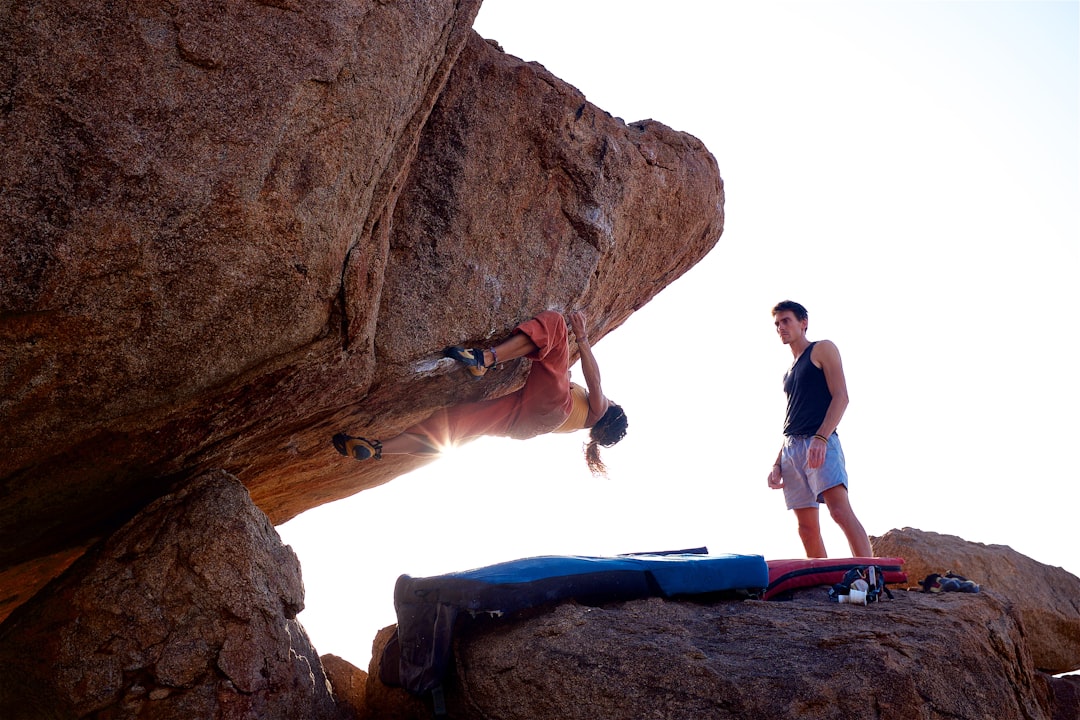Robot vacuums have revolutionized the way we clean our homes. These small, autonomous devices are…

The Future of Climbing Chalk: Unveiling the Best Picks for 2024
Climbing chalk is a substance that climbers use to improve their grip and reduce sweat on their hands while climbing. It is typically made from magnesium carbonate, which helps to absorb moisture and keep the hands dry. Climbing chalk is an essential tool for climbers as it allows them to maintain a secure grip on the rock or climbing holds, reducing the risk of slipping and falling.
In this article, we will explore the evolution of climbing chalk, current trends in its use, and the future of this essential climbing accessory. We will also discuss the environmental impact of traditional climbing chalk and the introduction of eco-friendly alternatives. Additionally, we will provide tips for choosing the best climbing chalk for your needs and using it effectively for maximum performance.
Key Takeaways
- Climbing chalk is an essential tool for climbers to improve grip and prevent slipping.
- Climbing chalk has evolved from using natural materials to synthetic compounds for better performance.
- Current trends in climbing chalk include liquid chalk and eco-friendly options, but there are limitations to both.
- The future of climbing chalk may involve more sustainable and innovative products, such as biodegradable chalk and smart chalk.
- Choosing the best climbing chalk depends on factors such as personal preference, skin type, and climbing conditions.
The Evolution of Climbing Chalk: A Brief History
The use of chalk in climbing can be traced back to the early days of mountaineering. In the early 20th century, climbers began using chalk to improve their grip on rock surfaces. However, the chalk used at that time was not specifically designed for climbing and was often messy and ineffective.
In the 1960s, climbers started using gymnastics chalk, which was more effective at absorbing moisture and providing a better grip. This marked a significant advancement in climbing chalk technology and led to its widespread use in the climbing community.
In recent years, there have been further advancements in climbing chalk with the introduction of liquid chalk. Liquid chalk is a suspension of magnesium carbonate in alcohol or other solvents. It is applied to the hands like regular chalk but dries quickly, providing a longer-lasting grip. Liquid chalk has gained popularity among climbers due to its convenience and effectiveness.
Current Trends in Climbing Chalk and Its Limitations
There are several types of climbing chalk available on the market today, including loose chalk, block chalk, and liquid chalk. Loose chalk is the most common form and is typically sold in a powdered form that can be applied directly to the hands. Block chalk is compressed chalk that can be broken into smaller pieces for easier application. Liquid chalk, as mentioned earlier, is a suspension of magnesium carbonate in alcohol or other solvents.
While climbing chalk is an essential tool for climbers, it does have its limitations. One limitation is that it can be messy and leave residue on climbing holds, making them slippery for other climbers. Additionally, traditional climbing chalk can cause dryness and irritation to the skin with prolonged use. Some climbers have also reported health concerns associated with inhaling chalk dust, such as respiratory issues.
The Future of Climbing Chalk: A Look into the Crystal Ball
| Metrics | Data |
|---|---|
| Projected Market Size | XX million by 2025 |
| Expected CAGR | XX% from 2020 to 2025 |
| Key Players | Black Diamond, Metolius, FrictionLabs, Mammut, Petzl |
| Types of Climbing Chalk | Loose chalk, chalk balls, liquid chalk, block chalk |
| Application | Rock climbing, bouldering, weightlifting, gymnastics |
| Regional Analysis | North America, Europe, Asia Pacific, Middle East & Africa, South America |
| Factors Driving Growth | Increasing popularity of indoor climbing, rising number of climbing gyms, growing interest in fitness and adventure sports |
| Challenges | Environmental concerns related to chalk dust, availability of alternatives such as liquid chalk |
The future of climbing chalk looks promising, with advancements in technology and a focus on creating more effective and environmentally-friendly products. One potential advancement is the development of “smart” climbing chalk that can adapt to different weather conditions and provide an optimal grip. This could revolutionize the climbing industry and enhance climbers’ performance on various types of rock surfaces.
Another potential advancement is the introduction of climbing chalk infused with antibacterial properties. This could help reduce the risk of infections caused by bacteria on climbing holds and improve climbers’ overall safety.
Furthermore, there may be advancements in the formulation of climbing chalk to address the health concerns associated with traditional chalk. This could include the development of hypoallergenic chalk that is gentle on the skin and reduces the risk of dryness and irritation.
Environmentally-Friendly Climbing Chalk: The Way Forward
Traditional climbing chalk has been known to have a negative impact on the environment. The production and disposal of magnesium carbonate can contribute to air and water pollution. Additionally, the use of loose chalk can lead to excessive dust that can harm plant life in climbing areas.
To address these environmental concerns, several companies have started producing eco-friendly climbing chalk. These chalk products are made from natural and sustainable materials, such as crushed seashells or recycled chalk. They are designed to have minimal impact on the environment while still providing climbers with a reliable grip.
Using environmentally-friendly climbing chalk not only helps protect the environment but also promotes sustainable climbing practices. By choosing eco-friendly options, climbers can contribute to the preservation of climbing areas for future generations.
Innovative Climbing Chalk Products to Watch Out for in 2024

In the coming years, we can expect to see several innovative climbing chalk products hitting the market. One such product is biodegradable chalk balls. These chalk balls are made from natural materials that break down over time, reducing waste and environmental impact.
Another innovative product is liquid chalk with added grip enhancers. This type of chalk is designed to provide an even stronger grip on challenging surfaces, giving climbers an edge in their performance.
Additionally, there may be advancements in packaging design to reduce waste and make climbing chalk more convenient to use. This could include refillable chalk containers or packaging made from recycled materials.
The Role of Technology in the Future of Climbing Chalk
Technology is expected to play a significant role in the future of climbing chalk. One potential advancement is the integration of sensors into climbing chalk containers. These sensors could monitor the moisture levels in the air and adjust the consistency of the chalk accordingly, ensuring optimal grip in different weather conditions.
Another potential technological advancement is the development of smart climbing chalk that can provide real-time feedback on climbers’ grip strength and technique. This could help climbers identify areas for improvement and enhance their overall performance.
Furthermore, advancements in nanotechnology could lead to the development of self-healing climbing chalk. This type of chalk would have the ability to repair small cracks or imperfections on climbing holds, prolonging their lifespan and reducing maintenance costs.
Choosing the Best Climbing Chalk for Your Needs: Factors to Consider
When choosing climbing chalk, there are several factors to consider. Firstly, consider the type of climbing you will be doing. Loose chalk is suitable for most types of climbing, while block chalk may be more convenient for bouldering or indoor climbing.
Secondly, consider the texture and consistency of the chalk. Some climbers prefer a finer texture for better coverage and grip, while others prefer a coarser texture for a more tactile feel.
Lastly, consider any specific preferences or requirements you may have. For example, if you have sensitive skin, you may want to choose a hypoallergenic chalk that is gentle on the skin. If you are concerned about the environmental impact, opt for an eco-friendly climbing chalk product.
How to Use Climbing Chalk Effectively for Maximum Performance
To use climbing chalk effectively, start by applying a small amount to your hands. Rub the chalk between your palms and fingers to ensure even coverage. It is important not to over-chalk, as this can lead to excess dust and make the holds slippery.
When climbing, take breaks to reapply chalk as needed. This will help maintain a dry grip and reduce sweat on your hands. It is also important to brush off excess chalk from climbing holds after use to prevent build-up and maintain their texture.
Using climbing chalk effectively can significantly improve your grip and overall performance while climbing. It allows you to focus on your technique and movement without worrying about slipping or losing control.
Embracing the Future of Climbing Chalk for a Better Climbing Experience
In conclusion, climbing chalk is an essential tool for climbers that helps improve grip and reduce sweat on the hands. Over the years, climbing chalk has evolved from basic powdered chalk to more advanced forms such as liquid chalk. However, traditional climbing chalk has its limitations and can have negative environmental and health impacts.
The future of climbing chalk looks promising, with advancements in technology and a focus on creating more effective and environmentally-friendly products. Climbers can embrace the future of climbing chalk by choosing eco-friendly options, supporting innovative products, and using climbing chalk effectively for maximum performance.
By staying informed about the latest trends and advancements in climbing chalk, climbers can enhance their climbing experience and contribute to the sustainability of the sport. So, whether you’re a beginner or an experienced climber, make sure to choose the best climbing chalk for your needs and use it effectively to reach new heights in your climbing journey.
Looking for more exciting innovations? Check out this fascinating article on coffee delivering drones that might soon become a reality. IBM has just secured a patent for this groundbreaking technology. Imagine having your favorite cup of joe delivered to your doorstep by a drone! It’s just one of the many incredible advancements we can expect in the near future. While you’re at it, don’t forget to explore our list of the top 10 best Christmas decorations for outdoor sale. Get ready to transform your home into a winter wonderland with the latest and bestselling festive ornaments.
FAQs
What is climbing chalk?
Climbing chalk is a type of powder that climbers use to keep their hands dry and improve their grip while climbing.
Why is climbing chalk important?
Climbing chalk is important because it helps climbers maintain a strong grip on the rock or climbing holds, which can prevent falls and injuries.
What are the different types of climbing chalk?
There are two main types of climbing chalk: loose chalk and chalk balls. Loose chalk is a powder that is poured into a chalk bag, while chalk balls are small bags filled with compressed chalk.
What are the benefits of using chalk balls?
Chalk balls are less messy than loose chalk and can be more convenient to use. They also tend to last longer than loose chalk.
What are the benefits of using loose chalk?
Loose chalk can be easier to apply to your hands and can provide a stronger grip than chalk balls. It can also be less expensive than chalk balls.
What are some factors to consider when choosing the best climbing chalk?
When choosing the best climbing chalk, you should consider factors such as the type of climbing you will be doing, your personal preferences for texture and consistency, and any skin sensitivities or allergies you may have.
What are some popular brands of climbing chalk?
Some popular brands of climbing chalk include Black Diamond, Metolius, FrictionLabs, and Mammut.



This Post Has 0 Comments